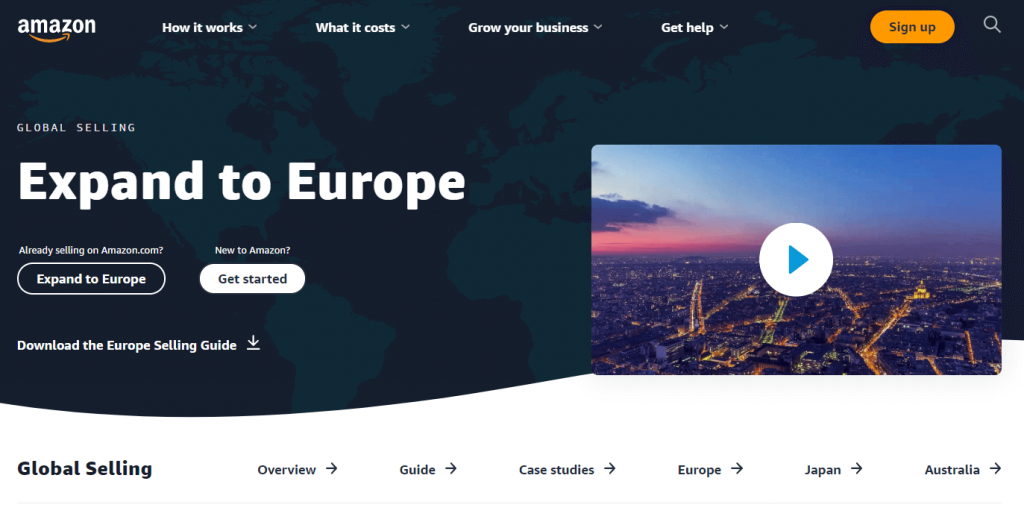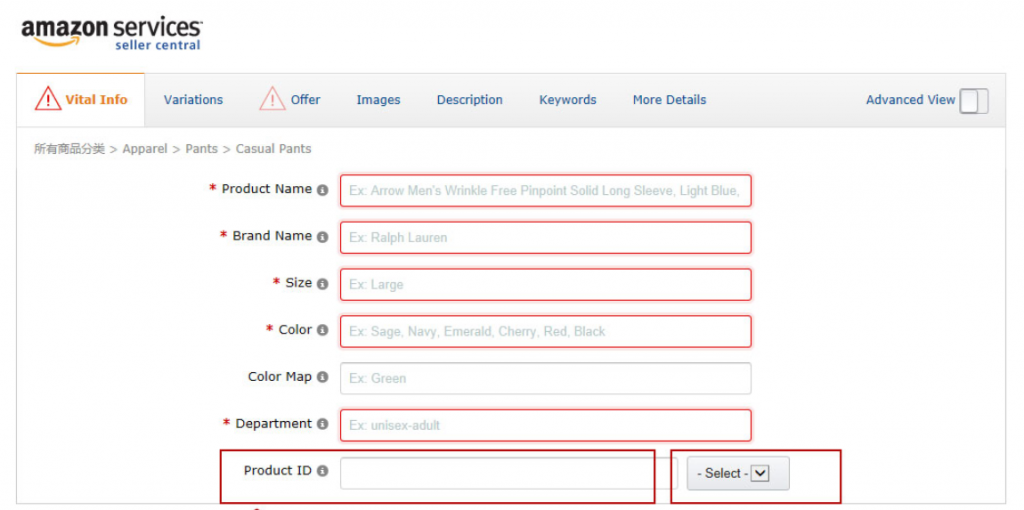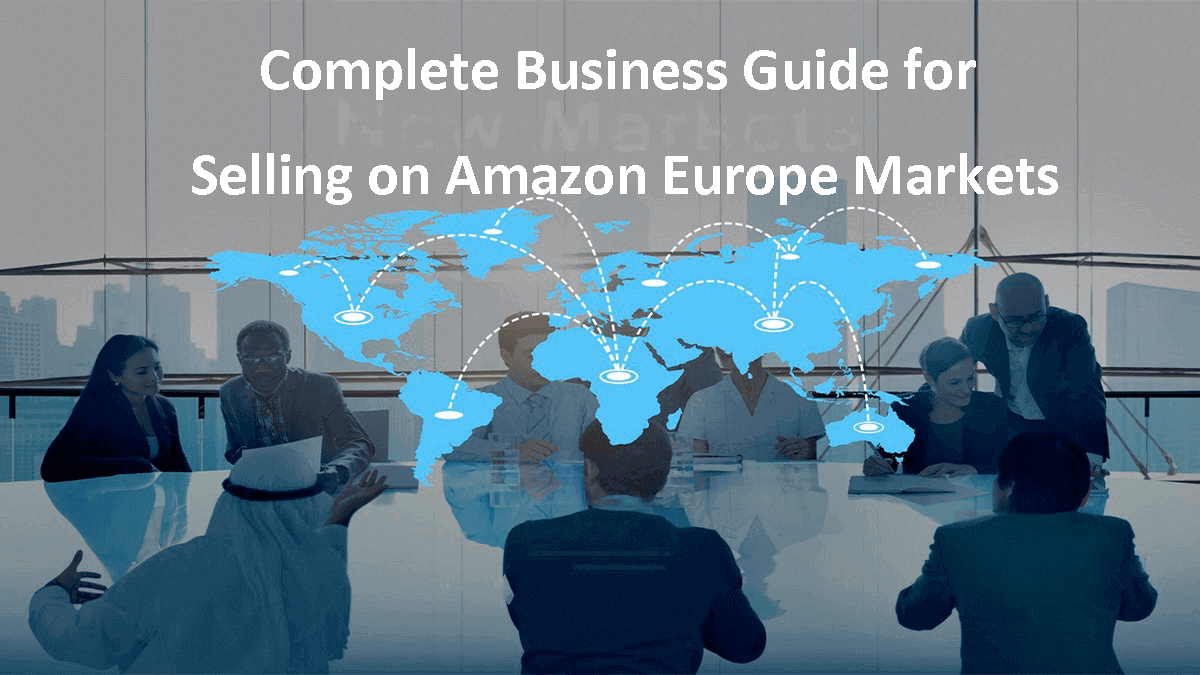To sell your products in an entirely different territory is a hassle! First, you need an e-commerce platform to connect you to customers.
Next, you also need licenses, lawyers, and understanding laws. Then there are shipment issues, storage issues, and so on!
This is where Amazon Europe, your business assistant, steps in, and saves the day. Selling on this global platform helps you with everything; from shipment to revenue collection.
Here is a step-by-step guide to selling on Amazon Europe. Let’s dive right into it.
Overviews of Amazon European Marketplaces

The Amazon e-market is spread all across the European Union. In 2019, Amazon’s European markets produced roughly 32 billion dollars, with approximately 1.1 million active users.
The most significant divisions of Amazon EU include amazon.fr, amazon.it, amazon.de and amazon.es and amazon.co.uk.
Each of these is a potentially powerful marketplace depending on seller product and preference.
90% of the UK’s online shoppers use Amazon, roughly 281,257. The number has increased by nearly 18% in the last year.
Naturally, sellers prefer to expand their business through Amazon UK. However, by doing so, the seller might be dismissing nearly 70% of the European market!
Therefore, it is better to compare shares and market revenues of each of Amazon’s European marketplaces.
The most significant revenues for Amazon EU have been produced by the UK and Germany, nearly 17% in sales. Collectively, they have produced 23 billion dollars in revenue in the past years!
Germany is currently a more prominent player in the market than in the UK. According to online statistics, Amazon generated a whopping 14.1 billion dollars in revenues in Germany in 2016.
Germany now produces 10.4 percent of the company’s total revenue, growing nearly 20%, and is considered the most significant market outside of the United States. So you should definitely take the German division into consideration
Similarly, other European markets, such as France, Italy, and Spain, might seem smaller. But they are growing in their potential, promising nearly 174 million potential buyers for your products.
Amazon looks forward to investing almost 550 million dollars in Italy and opening 1300 new warehouses all over the region.
These expansions are proof that European e-commerce is growing stronger day by day. According to E-commerce stats in 2018, 268 million European consumers made online purchases, worth 198 billion dollars in a year!
This highlights a massive rise of 9.4%. Currently, Amazon’s European market is the second-best in the worldwide ranking.
So, if you are determined to expand your business in the EU, Amazon offers the best and most established European platforms to do so.
You are promised millions of online customers daily that can massively enhance your sales potential.
What about Amazon Europe? Is it bigger and better?
Amazon reigns over online retail businesses. It has developed a customer database from all over the world, shipping products to 100 countries so far.
As of 2019, Amazon’s brand value amounts to approximately almost 315 billion dollars.
Amazon EU had a revenue of 32 billion dollars from its five different marketplaces, namely, Amazon.es, Amazon.fr, Amazon.co.uk, Amazon.de, and Amazon.it.
So yes, it is bigger.
But is it better? This can be easily explained with the resources provided. From lending its warehouses for product storage to customer service, Amazon EU handles everything.
It depends on your seller contract or plans how many of these services you can avail.
The company offers multiple seller plans for its sellers depending on their needs.
- The ‘Basic plan’ caters individuals who sell fewer than 35 items per month. They are only required to pay a fee when they sell something. In this plan, the website does not provide ads or advanced selling tools for the products.
- The Professional plan is for sellers with more than 35 items per month. They are required to pay a fixed monthly fee. The plan also includes advertisements, advanced selling tools like APIs, and top product placements.
Apart from these services, Amazon EU also helps with language and currency barriers that sellers might face. In conclusion, yes it is better.
How to Sell on on Amazon Europe?

To become a seller on Amazon Europe, you need to follow a simple procedure:
- The first important decision is to decide the product and the desired marketplace for it.
- Secondly, you need to go to their website and get yourself registered. Your account will consist of your basic details, like your phone number, a credit card number, and so on. They’ll also need you to enter your VAT number.
- To access all areas of the European market, sellers have to make product listings for each of the different European marketplaces where they are looking to sell.
- Furthermore, touch upon local and European tax and regulatory requirements. According to Amazon EU, it is your responsibility to ensure that you comply with applicable requirements.
- The most important thing you will need to provide is a bank account that is operational in a country that Amazon supports.
- Choose your shipment strategy; either FBA (Fulfilment by Amazon) or FBM (Fulfilment by Merchant).
Got your answers already? Now let’s get to the business step by step, shall we?
1. Decide which marketplace to sell
As mentioned earlier, you need to study your market before you leap into it. Amazon has stores operating in six European countries: Amazon.de, Amazon.co.uk, Amazon.fr, Amazon.it, Amazon.es, and Amazon.nl.
By the end of this year, it is expected that e-commerce sales will reach more than $370 billion in Europe!
With your European Unified Account, you can sell in multiple Amazon EU stores from a single account. This makes the process of listing, pricing, fulfillment, and payments easier for sellers.
2. Decide how to fulfill orders
Shipment is the most crucial part of your business. Most customer feedback and satisfaction depends on your timely delivery.
It is also essential your product is in ace condition and is delivered safely. It Amazon EU, there are multiple shipment options for you to choose from.
- Fulfillment by Merchant (FBM)
This means that a seller chooses to take the shipment responsibility on themselves. In this situation, Amazon EU is not responsible for any shipment logistics or details.
Shipping your orders all by yourself may seem like a good idea only if you’re selling a few items to customers and that too in your own country.
However, such an option for international shipments can be disastrous, to say the least.
If you choose FBM, you may ship your products manually, which is both time-consuming and expensive.
The other option is to buy or rent a European storage center which will be expensive as well. Your product will also have to go through customs with every delivery.
- Fulfillment by Amazon (FBA)
As the name suggests, FBA means Amazon lets you sit back while it handles all your shipment details and hassles.
When you avail of this service, Amazon takes your products, keeps them in one of its warehouses, and ships it to people who want to buy across the world, deals with all and any refunds and logistical details related to shipping your products.
Amazon does charge both a storage and shipment fee but it comes with stellar service.
Read also: FBA vs. FBM: Which Fulfillment Service is Best for You?
There are more further types of fulfillment methods:
- Pan European Fulfilment
Pan-European FBA is the easiest to understand and operate. After shipping your products once to one distribution center, Amazon will automatically divide it throughout the EU, based on demand.
This is a money-saver choice since you can send all of your stock as one shipment instead of sending several smaller ones to different European countries.
- FBA European Fulfilment Network (EFN)
This option includes shipping all of your products to a single fulfillment center in Europe. Amazon will not forward these to other fulfillment centers like with Pan European FBA.
When an order arrives from anywhere across Europe, it will be fulfilled from this one location.
- Multi-Country Inventory (MCI)
If you want to store your products in different EU countries’ distribution centers, then MCI is for you.
It gives you control over which products you want to store where and shipped from which country.
The big advantage of MCI is that you can ship orders from the closest center possible, promising faster and convenient shipping. Distribution of products also avoids over-stocking in one center.
Amazon has collected some reliable and professional services to help sellers ship their products to Amazon warehouses in different countries.
Sometimes, the services offer discounts and promotion rates so sellers can save money on their shipping.
You can check all shipping services here: Amazon shipping Service Provider Network.
3. Research Legal Obligations
When you begin a business in the European Union, you are expected to be aware of their customs laws and regulations that are applicable to the country.
Depending on the type of product, you may need licenses for shipment.
You must have intellectual property rights; including patents and copyrights. This is essential for listing your products and selling them across the EU.
Apart from this, there are different health and environmental restrictions in each EU country. Seller is obligated to study all laws and regulations before initiating a trade.
What is VAT? Is it necessary?
Value Added Tax (VAT), is collected on imports that are distributed between EU countries. It is essential for the seller to calculate the VAT according to product and shipment locality.
It is recommended to begin understanding VAT procedures as soon as you register on Amazon EU. Their official website also helps in processing it for its sellers.
See also: 10 Free Amazon VAT Invoice Generator You Should Never Miss
4. Register a seller account
The first step to sell in a different region is to create a seller account within that region.
If you have a Professional Seller account, you can operate it across the EU. For a seller account, you need to provide your Credit card, phone number, company registration details, bank account information to receive sales and VAT number.
5. Decide on your Payment Options
To receive payments, you can open a bank account in your country of business.
This might be complex as you may have to undergo an entirely legal process to introduce your business.
Your customers can pay in their own currencies as Amazon offers a currency conversion service.
In return, Amazon EU charges a 3% conversion rate and deposits the money as soon as payment is received.
6. Research your products based on different countries’ needs
A thorough understanding of your product is necessary before you decide to ship it to different fulfillment centers.
For this, you need to study product demand in your desired region or start with smaller sales rather than a bulky shipment to one corner of the EU.
It is highly possible that your product demand may differ in even different countries of a single EU.
Finding the right niche product is important and you can use some product research tools to help you automate the process.
With the help of tools, you will be able to identify the right products to sell on Amazon and maximize your margins.
7. List your products on Amazon.
Product listing is the product page for each of the items you choose to sell on Amazon. It includes product information such as title, material, images, description, and price.
These listings make your product visible on Amazon searches and promote it as well. Amazon EU requires you to translate your lists according to your region of shipment.
There are 5 easy steps to list your products on Amazon:
- Log into your Amazon seller central account
- Hover over ”INVENTORY” tab on the navigation bar
- Click on ”Add a product” to create a new product listing”
- Finish all the detailed product info and upload product images
- Click on ” Save and Finish” to publish your listing

After listing your products on Amazon, don’t leave it as it is. You won’t get a sale if no buyer has ever reached to your items.
You need to learn some listings optimization tips to turn your product from the unknown to the best selling lists.
8. Optimize your listings and start to get sales
You are never entirely done with your product listing on Amazon EU. It is a continuous procedure that must be updated periodically.
What improves your product listings quickly are getting more customer feedback and ratings. This is why usually sellers probe their buyers to leave feedback after receiving their products.
To get more reviews, the easiest way to do so is to send review request emails to buyers and politely ask them to leave reviews on your products.
A review request tool such as AMZFinder, can help you automatically send out request emails to buyers and keep track of your reviews so you will be able to know what your customers said about your items.
Try it with a 30-day free trial, you won’t lose anything!
What Sellers Should Know About Selling on Europe?
The European e-commerce market is one of the best ways to expand your business internationally.
It is estimated the annual revenue in 2017 was close to 680 billion dollars! It has grown ever since. A large chunk of this revenue came from the e-commerce king, Amazon EU.
Your basic checklist of information before selling on the great European marketplace should include:
- Seller account
- product demand
- fulfillment process
- currency exchange
- customer management techniques
While selling on Amazon European countries, there are some important things that you should know:
- There are some restricted categories that sellers cannot sell on the European marketplaces.
- For European accounts, Amazon Know Your Customer (KYC) account verification is a necessary step to pass Amazon’s auditing. If you cannot pass it, your seller account will be closed and the money will not be returned to you. Thus, sellers must attach great importance to the completeness and accuracy of all information provided in order to pass the verification process.
- Sellers only need to register one seller account on Amazon which enables you to sell across all European marketplaces.
- It is necessary to register a VAT number before selling on European marketplaces. The VAT tax rates vary in European countries. Usually, it is around 20% according to different product categories. In this case, sellers will need to take tax costs into account while pricing their items.
Conclusion
By now we hope you have a clear understanding of the workings of Amazon Europe. You are now well aware of all the essential steps required to start selling with Amazon EU.
From making a seller account to managing customer services, Amazon shall be your business partner through and through.
You may also like:
Complete Guide on How to Create an Amazon Seller Account
How to Get Verified Reviews on Amazon in 2020?
Shopify vs. Amazon: Which Platform is Profitable to Sell on?
A Complete Tutorial on How To Sell on Amazon Australia
8 Tips To Increase Your Amazon Conversion Rate

Leave a Reply
You must be logged in to post a comment.